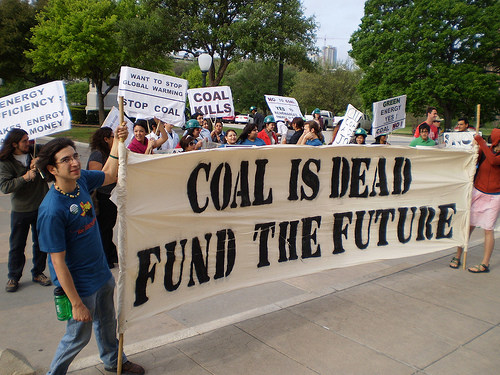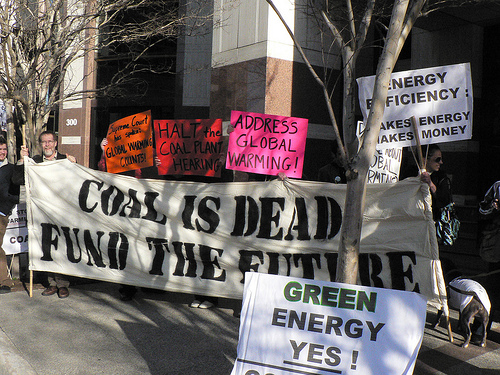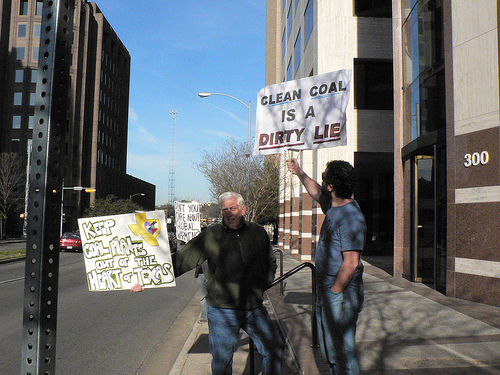 Residents Who May Be Affected by Plant’s Pollutants Should Tell the Judge
Residents Who May Be Affected by Plant’s Pollutants Should Tell the Judge
AUSTIN – Next Monday marks the last chance to register as legal opponents to the White Stallion power plant proposed near Bay City, and Public Citizen is urging people to attend. Opponents have organized a group called the No Coal Coalition around concerns for air quality, water use, the health effects of increased pollution and the plant’s potential contribution to global warming.
The White Stallion Energy Center is slated for construction just 10 miles south of Bay City. The State Office of Administrative Hearings (SOAH) will conduct a preliminary hearing on the White Stallion Energy Center at 10 a.m. Monday, April 20, at the Bay City Convention Center.
Anyone with concerns or who anticipates being affected by air contaminant emissions from the facility may attend Monday’s hearing and request to be a party to the case. A SOAH judge will decide who will be eligible to participate in the case; the actual contested case hearing, which will be in about six months, will be a legal proceeding similar to a civil trial in state district court.
“We are extremely concerned about the White Stallion plant,” said Robert M. Malina, Ph.D, a Bay City resident representing the No Coal Coalition and a professor emeritus with the Department of Kinesiology and Health Education at the University of Texas at Austin.” If built, White Stallion would emit thousands of tons of pollution, which could have serious health consequences for a large number of people and the environment. Emissions from coal plants can complicate asthma, cardiac pulmonary disease, and many other circulatory and respiratory conditions. Mercury and lead, both emitted in large quantities from coal and petroleum coke plants, accumulate in our bodies and the environment and are associated with serious developmental problems in children. Simply stated, the White Stallion plant should not be built.” (more…)
 We’re already getting push-back from coal industry on account of the ReEnergize Texas Rally at the capitol Monday morning. When the coal industry’s “clean coal” PR machine is running scared and feels the need to release official press releases… you’re doin’ it right.
We’re already getting push-back from coal industry on account of the ReEnergize Texas Rally at the capitol Monday morning. When the coal industry’s “clean coal” PR machine is running scared and feels the need to release official press releases… you’re doin’ it right. Yesterday morning we held a press conference to highlight the importance of the proposed coal moratorium bill, SB 126, sponsored by State Sen. Rodney Ellis, and its companion bill in the house, HB 4384, sponsored by Rep. Allen Vaught.
Yesterday morning we held a press conference to highlight the importance of the proposed coal moratorium bill, SB 126, sponsored by State Sen. Rodney Ellis, and its companion bill in the house, HB 4384, sponsored by Rep. Allen Vaught. The Houston Chronicle ran an Op-Ed Sunday entitled
The Houston Chronicle ran an Op-Ed Sunday entitled  Last Friday two administrative law judges refused to hear testimony on the impact of carbon dioxide emissions during the permitting process for the NRG Limestone coal-fired power plant. The contested case hearing for NRG’s air quality permit application will be going on all week long, but testimony on the proposed plant’s contribution to global warming will not be allowed. The judges decided that the TCEQ has adopted clear policies that they would not consider testimony on the issue, even though the Supreme Court ruled in 2007 (
Last Friday two administrative law judges refused to hear testimony on the impact of carbon dioxide emissions during the permitting process for the NRG Limestone coal-fired power plant. The contested case hearing for NRG’s air quality permit application will be going on all week long, but testimony on the proposed plant’s contribution to global warming will not be allowed. The judges decided that the TCEQ has adopted clear policies that they would not consider testimony on the issue, even though the Supreme Court ruled in 2007 ( In protest, local environmentalists gathered for an 8:30 a.m. protest Monday Feb 22 outside the State Office of Administrative Hearings. Groups supporting the protest included: Public Citizen, SEED Coalition, Environment Texas, Clean Water Action, Re- Energize Texas, and the Texas Climate Emergency Campaign.
In protest, local environmentalists gathered for an 8:30 a.m. protest Monday Feb 22 outside the State Office of Administrative Hearings. Groups supporting the protest included: Public Citizen, SEED Coalition, Environment Texas, Clean Water Action, Re- Energize Texas, and the Texas Climate Emergency Campaign. Feb 11, 2009
Feb 11, 2009 Today the House and Senate are working to reconcile their different versions of the long-awaited economic stimulus package. The stakes are now higher than ever for Texans, who stand to gain from billions that could go toward developing renewable energy and efficiency in the state, reducing pollution from diesel engines, and cleaning up abandoned nuclear waste sites.
Today the House and Senate are working to reconcile their different versions of the long-awaited economic stimulus package. The stakes are now higher than ever for Texans, who stand to gain from billions that could go toward developing renewable energy and efficiency in the state, reducing pollution from diesel engines, and cleaning up abandoned nuclear waste sites. Hey Look! A press release from SEED Coalition and Public Citizen:
Hey Look! A press release from SEED Coalition and Public Citizen:

